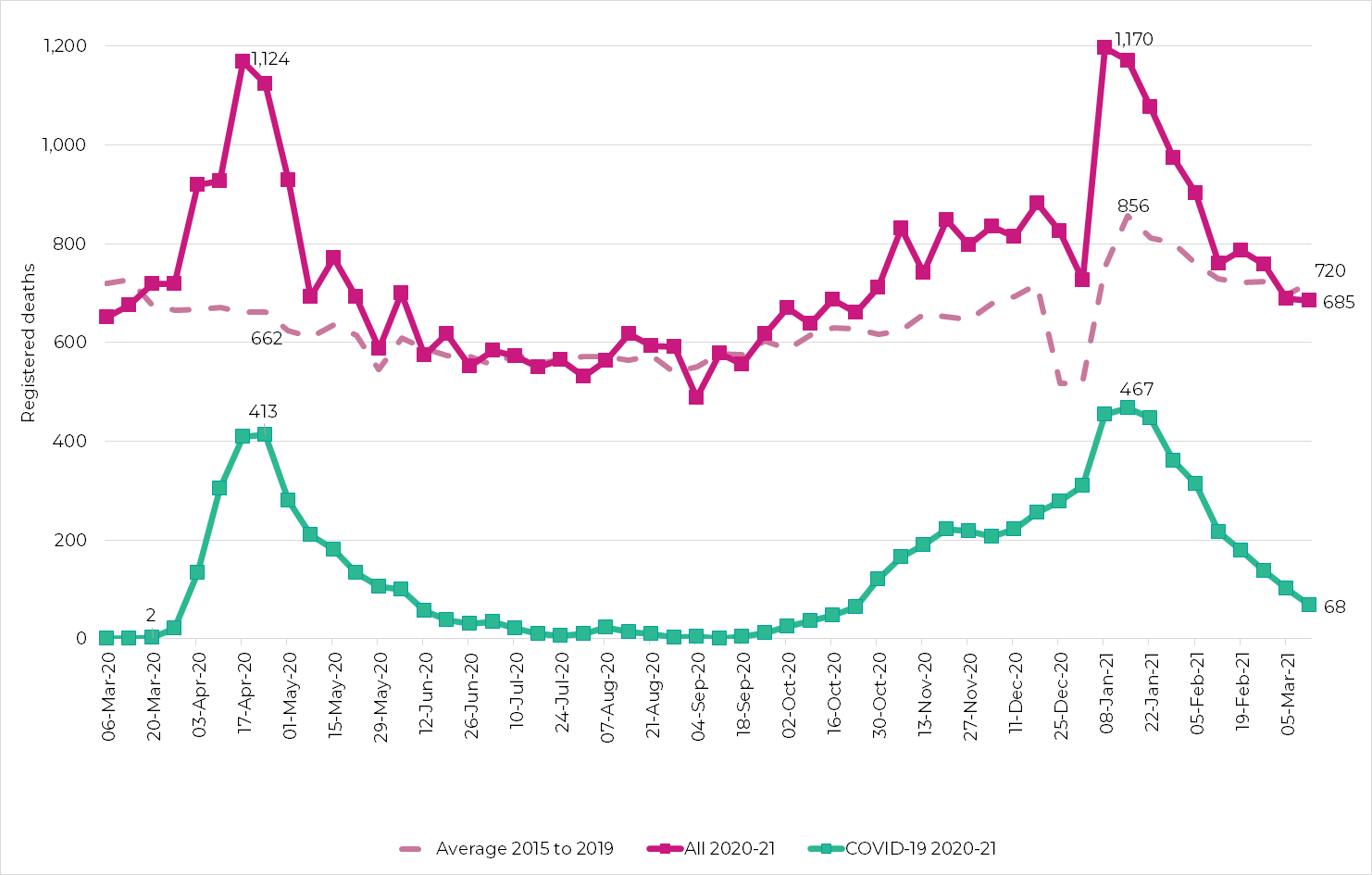Senedd Research stops publishing new research and analysis during the pre-election period, from 7 April to 6 May. This article won’t be updated during this time. You can find links to the most recent data and information in our Coronavirus (COVID-19) signposting article.
Each week the Office for National Statistics (ONS) publishes Deaths registered weekly in England and Wales. This data provides provisional counts of the number of deaths registered in England and Wales, including deaths involving the coronavirus (COVID-19). To allow time for registration and processing, these figures are published 11 days after the week ends. So the figures published on 23 March 2021 show weekly deaths up to the week ending 12 March 2021.
The ONS figures are based on the date the death was registered rather than the date the death occurred. There is usually a delay of at least five days between a death occurring and being registered.
Latest ONS data (week ending 12 March)
All registered deaths and COVID-19 deaths
Figures from the ONS show all registered deaths including people who died in the community as well as in hospital. This allows us to see how many more people have died from all causes than we would usually expect by looking at a 5 year average. ONS use 2015 to 2019 as a five-year average because of the impact of the COVID-19 pandemic on deaths registered in 2020. Increases in deaths above the five-year average are often known as 'excess deaths'. The latest data show the number of registered deaths are below the 2015 to 2019 five year average for the second week running in 2021. ONS states that trends in week 1 of 2021 should be interpreted with caution:
The number of deaths in Week 1 (2021) is likely to have been increased by late registrations from the previous week, which included both the Boxing Day and New Year's Day Bank Holidays, so comparisons should be interpreted with caution.
The data also show the number of COVID-19 deaths in Wales starting in the week ending 20 March 2020. There were 68 COVID-19 deaths in the week ending 12 March 2021.
Weekly provisional deaths registered in Wales in 2020-21 compared to the average over 2015-2019.

Source: ONS, Deaths registered weekly in England and Wales, provisional
Place of COVID-19 deaths
ONS data is also published by local authority, health board and place of death which includes hospital (acute or community, not psychiatric), home, care home, hospice, other communal establishment and elsewhere.
From the week ending 20 March 2020 to the week ending 12 March 2021, 72.1% (5,574) of COVID-19 deaths occurred in hospitals, 21.4% (1,652) in care homes, 5.1% (395) at home and 1.4% (110) in other places.
COVID-19 deaths by local authority and place of death
The graph below shows the total number of COVID-19 deaths occurring in Wales from week ending 20 March 2020 to week ending 12 March 2021 but were registered up to 20 March 2021, by local authority of residence and place of death. This shows that Rhondda Cynon Taf has the highest number of COVID-19 deaths and Isle of Anglesey the lowest. In this week Powys (9), Cardiff (7) and Rhondda Cynon Taf (6) saw the highest number of deaths.
COVID-19 deaths by local authority of residence and place of death occurring from 20 March 2020 to 12 March 2021, registered up to 20 March 2021

Source: ONS, Death registrations and occurrences by local authority and health board
Deaths involving COVID-19 – ONS interactive map
ONS has produced an interactive map which shows the number of deaths occurring in the period March 2020 to February 2021, where COVID-19 was mentioned as a cause on the death certificate. Middle Layer Super Output Areas (MSOAs) have been used as the geography as they have similar population sizes and remain stable over time. There are 410 MSOAs in Wales, each with a population of between 5,000 and 15,000.
Number of deaths involving COVID-19 in Middle Layer Super Output Areas, death occurring between March 2020 to February 2021, England and Wales.
Source: ONS, Deaths involving COVID-19 – interactive map
Why are the ONS figures different to the PHW figures?
ONS explain these figures differ to those published by Department of Health and Social Care in England (DHSC) and Public Health Wales (PHW):
These figures are different from the daily surveillance figures on COVID-19 deaths published by the Department of Health and Social Care (DHSC) on the GOV.UK website, for the UK as a whole and constituent countries. Figures in this report are derived from the formal process of death registration and may include cases where the doctor completing the death certificate diagnosed possible cases of COVID-19, for example, where this was based on relevant symptoms but no test for the virus was conducted.
PHW figures include reported deaths in a hospitalised patient or care home resident where COVID-19 has been confirmed with a positive laboratory test and the clinician suspects this was a causative factor in the death. PHW death figures are published by local health board but not by local authority or place of death.
If you are interested in reading more about PHW statistics see our blog Coronavirus: statistics.
Article by Helen Jones, Senedd Research, Welsh Parliament
We’ve published a range of material on the coronavirus pandemic, including a post setting out the help and guidance available for people in Wales and a timeline of Welsh and UK governments’ response.
You can see all our coronavirus-related publications by clicking here. All are updated regularly.






